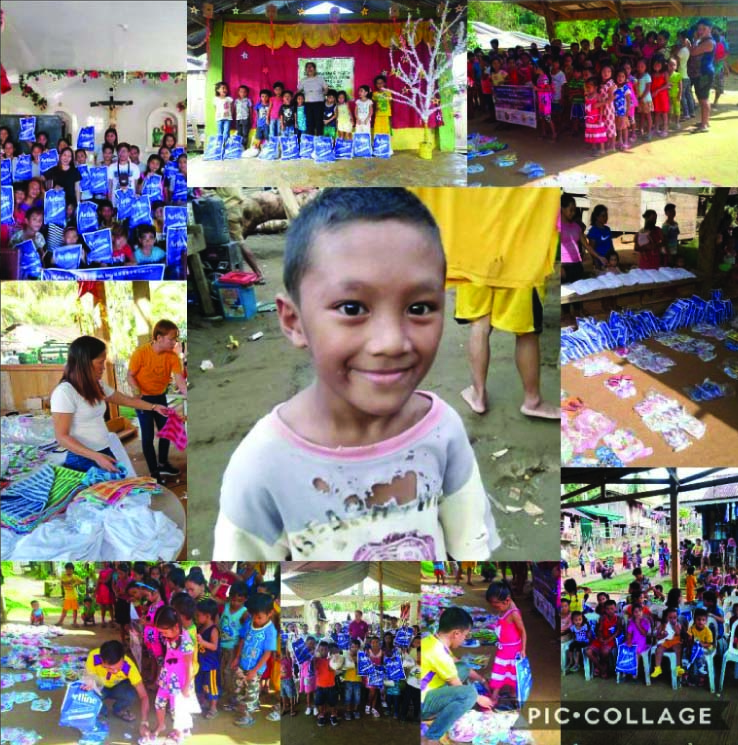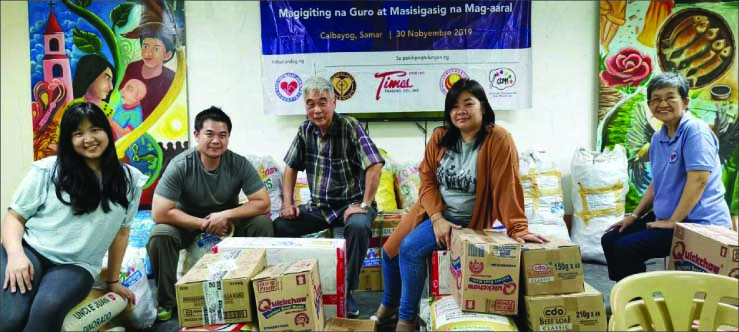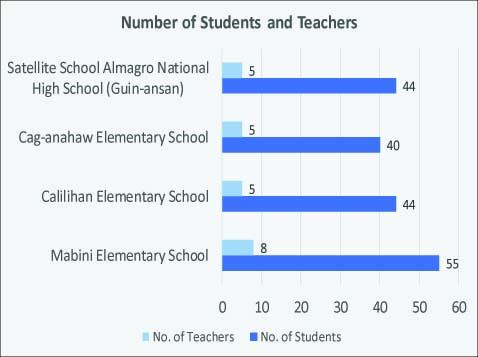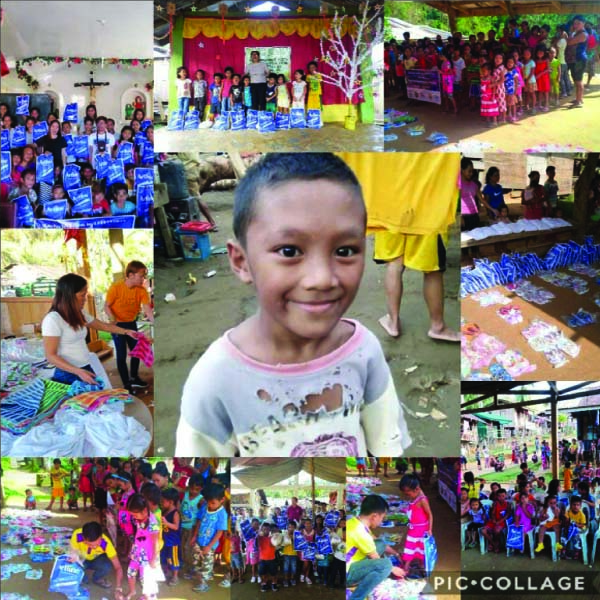
Typhoon Tisoy (Kammuri) made landfall in Samar on Dec. 2.
Just before that, on Nov. 29-30, volunteers of Kaisa Para Sa Kaunlaran distributed early Christmas gifts for students and teachers at four public schools in Calbayog City, Samar.
Kaisa’s presence and the goods we brought were providential. When plans were being made for the Calbayog outreach in October, Typhoon Tisoy was not on the horizon yet.
Two of the items donated were put to use immediately: solar lamps to provide light when electricity was cut off and laminated sheets to protect supplies from leaky roofs and flimsy walls.
How it started
A chance encounter between me and Jover Laurio, who writes the Pinoy Ako Blog, started the project. Laurio shared the stories of the teachers in remote mountain and island schools and told me that they have given teachers’ kits for the teachers but many of the poor students don’t even have slippers.
I promised to send slippers. But it did not end there.
By chance, I was visiting Felisa Chua, founder and key motivator of the Parkway Love Fellowship, and shared with her that Laurio was looking for slippers for the students. She said she has 200 pairs right there and 120 face towels which she can share.
I shared with Kaisa the stories of the Calbayog schools and asked if the board wanted to take it on as a project. I told them that school supplies for the kids is one of the urgent needs. Reply was positive. Our past president, Eleonor Tsumura, immediately committed to give T-shirts for the students and teachers. As I often emphasized, “What’s meant to happen, will happen.”
Part of the funds for the Calbayog project came from family and friends who donated to Kaisa in lieu of flowers for the wakes of Elizabeth Gokongwei and Chua Le Guat, the mother of our past president and Tulay managing editor Ang Chak Chi.
My call to Michael Tan of Times Trading got a commitment to provide school supplies. Times Trading gave much more than what Kaisa had solicited.
Dr. Willie Ong sent 200 pairs additional slippers. Ang’s Saint Jude Catholic School classmate, Shirley Lu Tan, added 500 more pairs, which we were able to share also with our comfort women group.

Our partners
Kaisa president Michael Guzman called up the Filipino Chinese Amity Club Inc.’s Manila headquarters and learned that they have a chapter in Tacloban, three hours away from Calbayog. Guzman gave me the contact information of Amity Club Tacloban Chapter.
The Amity Club was formed in 1975 to help in the work as liaison between the Chinese-Filipino community and the Chinese Embassy when diplomatic relations were established with the People’s Republic of China.
Amity Tacloban committed two vehicles, one to bring the volunteers to Calbayog and another to bring goods donated by the organization, rice and canned goods for the four schools. Their vice president, Samuel Ngo was assigned to be our liaison.
Kaisa board member Baldiwn Kho, Laurio and I met at the National Museum for the logistics of transporting the school supplies, slippers, T-shirts, additional towels to Calbayog via DLTB bus plying Pasay City in Manila and Samar. Laurio was all gungho to go with us but the day after we met, she suffered a stroke.
She volunteered Lorelei Aquino, her other partner with Team Filipinas, nongovernment organization headed by Harvey Keh, to go with our volunteer team.
Andrew Tuason, a Kaisa board member, was designated project head. Kho solicited additional supplies like crayons and art supplies as well as hygiene kits and bought supplies for four big medicine boxes for each school, as Tuason suggested.
He did the nitty gritty job of organizing logistics, distributing the goods to four schools, packing them and readying them for transport. Kho was assigned to bring the goods to DLTB station with the help of Laurio’s volunteer, Sherwin Licup.
We haggled to bring down the cost of transport. Licup asked the office to call up the bus station manager to give us a discount. As it was, we still had to give some extra consideration to the bus driver and dispatcher to facilitate transporting the goods immediately.
Laurio’s cousin, Neil Dexter Bernales, was assigned to pick up the goods from the DLTB station in Calbayog. He was to bring them to the Department of Education Multi-Purpose Hall where the distribution was scheduled. Eight teachers from DepEd helped bring the goods to the schools.
News of the impending typhoon forced the Kaisa team to cancel a planned visit to one of the schools.

Team Calbayog
Our team of volunteers from Manila checked in at 3:30 a.m. at the Terminal 4 to catch the Air Asia flight. As early as 2.30 a.m., Aquino and I left the house to pick up Tuason and another volunteer, Misha Hwang, 21 and a new university graduate.
The Air Asia terminal was chaotic because a big group of athletes for the Southeast Asian Games was also checking in. Fortunately for me, there was a “senior” lane that allowed me to avoid the long line.
Sidetrips
The unexpected bonus from the project was the side trips to the Samar Archaeological Museum at the Christ the King College in Calbayog and a prawn farm run by a Taiwanese for two decades now.
Museum curator Carl Jamie Simple S. Bordeos enthusiastically toured us around the museum and the highlights of unique findings and artifacts from Samar’s early history. The stone tools and trade ceramics displayed demonstrate the early trade relations with China.
The visit to the prawn farm was an enlightening experience too. The workers lowered the net and came up with live prawns jumping high. Hwang was game but shrieked when she was asked to hold one.
It was heart-warming to see how the Philippines could be such a rich haven of productivity for those willing to work and how these investors could provide jobs and livelihood to the community.
Lessons learned
My usual pre-departure briefing include first explaining to the group what is Kaisa by pointing out our Kaisa logo. We have one heart that beats for our fellowmen regardless of race, social status, religion or beliefs. We have two hands, Tsinoys and Pinoys, clasped together in unity to steer the round circle, symbolizing the wheel of progress.
Then I admonished the group that in all outreach events we undertake, we prepare well but we go with open minds and hearts, hope for the best, face the unexpected, and ready for the worse scenario. The after-project debriefing was a revelation.
Aquino, being an NGO volunteer, was expectedly ready and cooperative. She shared that she was surprised and truly comforted to see that we Tsinoys treated the recipients with dignity, did not look down on them and genuinely sympathized with their difficulties.
Tuason and Hwang proved to be excellent helpers. They carried their weight, helped arrange the goods into four piles for the four schools, carrying the heavy sacks themselves.
Their anecdotes and jokes lightened the trip and educated this lola on what the young ones are thinking. Hwang shared that she is especially happy to be a volunteer in this project. I was surprised to hear her say she is unhappy whenever there is a call for volunteers and her circle of friends just offers to give money instead of time and effort.
All three of them shared a sense of fulfillment for having done a challenging but rewarding job. The teachers’ gratitude was reward enough for them.
Truly, the Kaisa spirit of oneness, unity of purpose, shone through from the initial preparation, to the superb teamwork and the actual execution of a small project that brought so much joy to everyone, volunteers and recipients alike.
